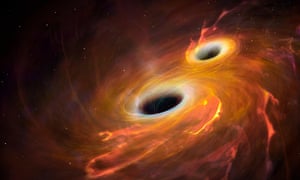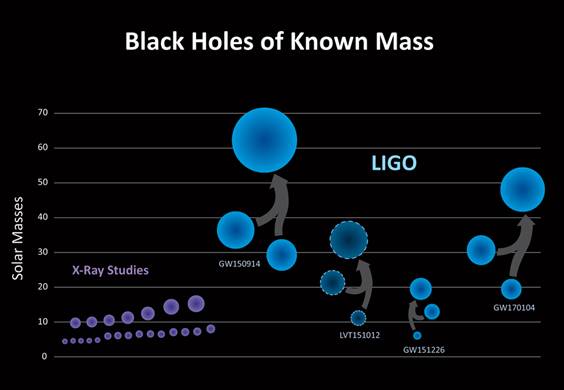Astronomers have made a new detection of gravitational waves and for the first time have been able to trace the shape of ripples sent through spacetime when black holes collide.
The announcement, made at a meeting of the G7 science ministers in Turin, marks the fourth cataclysmic black-hole merger that astronomers have spotted using Ligo, the Laser Interferometer Gravitational-Wave Observatory. The latest detection is the first to have also been picked up by the Virgo detector, located near Pisa, Italy, providing a new layer of detail on the three dimensional pattern of warping that occurs during some of the most violent and energetic events in the universe.
A tiny wobble in the signal, picked up by Ligo’s twin instruments and the Virgo detector on 14 August, could be traced back to the final moments of the merger of two black holes about 1.8bn years ago. The black holes, with masses about 31 and 25 times the mass of the sun, combined to produce a newly spinning black hole with about 53 times the mass of the sun.
Q&A
What is a gravitational wave?
The remaining three solar masses were converted into pure energy that spilled out as deformations that spread outwards across spacetime like ripples across a pond. Detecting these tiny distortions has required detectors sensitive enough to measuring a discrepancy of just one thousandth of the diameter of an atomic nucleus across a 4km laser beam.
Ligo scientists’ historic observation of gravitational waves in September 2015, marked the first experimental proof of Einstein’s prediction a century ago that space itself can be stretched and squeezed. However, the parallel orientation of the two Ligo detectors, one in Hanford, Washington state, the other in Livingston, Louisiana, has meant that scientists are effectively observing one flat plane through space, rather than getting a 3D picture.
“It’s like if I give you just one slice of apple, you can’t guess what the fruit looks like,” said Prof Andreas Freise, a Ligo project scientist at the University of Birmingham.
This was intentional because it maximised the chances of detection – a discovery that is hotly tipped to be rewarded when the Physics Nobel Prize is announced next week. However, the configuration made it impossible to test a second crucial prediction of Einstein’s theory – the shape of the path that the waves travel along.
Virgo’s arms are angled differently than the two Ligo detectors, allowing astronomers to extract new information about the polarisation of gravitational waves – essentially the path traced out by the vibrations.
“When you see things from different angles, suddenly you can see the 3D shape as well,” he said. “Einstein’s theory of what [the waves] look like is pretty clear.”
Einstein’s theory predicts two polarisations of gravitational waves, but some competing theories of gravity predict up to six.
Prof Stefan Ballmer, a physics professor at Syracuse University, explains: “If you look at how you can bend the sheet of paper that spacetime is, there are many ways you can bend it. But if you look at [Einstein’s predictions], only two of those ways are present.”
The new data – albeit based on a single detection – already appear to strongly favour Einstein’s predictions of how spacetime is expected to crumple.
Combining results from three detectors has also allowed scientists to more accurately triangulate the area of sky from which the waves are emanating. In future, this could allow scientists to swing ground-based telescopes to the target locations to see whether there is any visible trace of the collision itself.
Dr John Veitch, of the University of Glasgow, who co-led a team working on determining the origins and properties of the source, said: “This was a very strong first. Having a third detector means that we can now triangulate the position of the source, and much more accurately determine the exact spot in the cosmos where the signal came from.”
In the case of black holes, theory predicts that there should be no optical signal – but astronomers are open-minded.
“They should be dark ... but black holes are a mystery still to some extent,” said Freise. “We’re only getting signals from them for the first time, the rest is just theory.”
Virgo has been collecting data since 2007, but the instrument was offline undergoing upgrades when Ligo made its first detections of gravitational waves in 2015. The revamped detector was switched on earlier this year, meaning it had a short overlap with Ligo’s observing run, which came to an end in August.
“This is just the beginning of observations with the network enabled by Virgo and Ligo working together,” said Ligo spokesman David Shoemaker of MIT. “With the next observing run planned for [autumn] 2018 we can expect such detections weekly or even more often.”
UK science minister Jo Johnson said: “The latest detection of gravitational waves is an excellent example of international collaboration, which was only made possible due to the breakthrough work undertaken by UK scientists and engineers.”

